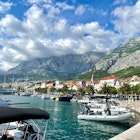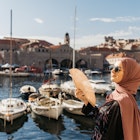
Montenegro vs Albania: how to choose between two Balkan beachfront countries



Montenegro (Perast pictured left) and Albania (Dhërmi pictured right) should both be on your travel wishlist. But how do you decide which one to visit first? L: Olena Znak/Shutterstock. R: Dave Long/Getty Images
You may already be plotting next year's summer holiday. Perhaps you're looking at places like Greece, Italy and Croatia, but would prefer fewer crowds or more affordable prices. If so, it's worth skipping over to their beautiful neighbors, Montenegro and Albania.
These two Balkan powerhouses – where Adriatic coastlines meet lively small towns and rugged mountains meet the sea – bring their own flavor to a European getaway. While popular tourist regions like the Bay of Kotor and the Albanian Riviera attract big numbers, there are still plenty of tucked-away corners where you'll easily find space to breathe. The only question is, which destination do you choose? Two of our expert writers have chosen sides, arguing in favor of the country they feel most passionately about. Can they tempt you to come over to their side? Or perhaps they'll end up convincing you to visit both?

Montenegro is wild, untamed and wonderful
Author of over a dozen guidebooks and contributor to 40 more, Rudolf Abraham has been visiting Montenegro for more than 20 years, lived in neighboring Croatia, and wrote the first English-language guides to hiking in Montenegro as well as the Peaks of the Balkans in Montenegro, Kosovo and Albania.
Within an area not much larger than the Falkland Islands – that’s less than half the size of Albania – Montenegro packs in a walloping punch. Behind that balmy, sun-drenched coastline, there’s a wildly convoluted landscape, which looks like someone scrunched up the Earth’s surface in order to fit in as many rock-strewn mountains as possible.
If you love your great outdoors wild and untamed, there’s little in Europe to match Montenegro. Rugged, remote and awe-inspiring, Montenegro’s spectacularly beautiful mountains are a hiker’s paradise, including five national parks, and with a well-marked network of hiking trails leading you off into the back of beyond. Slicing right through one of the highest areas, Durmitor National Park is one of the deepest canyons in Europe, carved by the River Tara as it snakes its way beneath near-vertical walls. Fancy trying out some truly world-beating white water rafting? The River Tara is the one for you. And if it’s culture you’re after rather than adrenaline, hidden away among these mountains, you’ll find some extraordinary medieval monasteries – from the Morača Monastery with its 13th-century frescoes to Ostrog, which is built into the face of a cliff.

And then there’s the coast. Both Montenegro and Albania sit on a gorgeous stretch of the Adriatic, facing Italy – but something that Montenegro has, and Albania does not, is the Bay of Kotor. This wildly indented bit of coastline enclosing a bay shaped like a double anvil – the entrance to which is narrow enough that they used to hang a chain across it – is a gob-smackingly beautiful place with the UNESCO-listed old town of Kotor at one end, a wall of mountains surrounding it, and some absurdly photogenic little islands just offshore from Perast, one natural and the other artificial, with a church and a monastery respectively.
Kotor itself is a labyrinth of narrow streets and alleys surrounded by medieval walls. That might sound a bit like a better-known walled city just over the border in Croatia, but with most things at a fraction of the price, you’ll understand why Kotor is so popular (including as a day trip from across the border). Fancy something a little less familiar? Head south to the ruins of Stari Bar, an old town up in the hills above Bar itself, surrounded by ancient olive groves (and by ancient, I mean up to 2000 years old, or more).

Montenegro and Albania each share a sizable chunk of Lake Skadar. At up to 530 sq km (205 sq miles), it is the largest lake in the Balkans by quite some measure, surrounded by vast reed beds and brooding mountains, its surface dotted with water lilies and water chestnuts. This is the perfect place for kayaking and is one of the most amazing birdwatching areas in southeast Europe, a place to see Dalmatian pelicans, squacco herons, as well as huge numbers of pygmy cormorants. But, allow me to focus on the Montenegrin side only – in addition to all the above, the Montenegrin side just happens to border, very conveniently, with the country’s best wine region. Near the town of Virpazar, the Crmnica wine region is the place to try lip-smackingly good reds from small-scale producers, and fill up your bags with bottles accordingly. The local wine is offset by delicious regional cuisine, which is earthy, seasonal and reason enough to come to Montenegro in itself.
This big-hearted, easygoing combination of spectacular scenery, fabulously rich culture and culinary pleasures all within such a compact area is Montenegro’s greatest drawcard. There are not many places where it's feasible to hike up one of any number of vertiginous 2000m (6562ft) limestone peaks, and then go for a lazy swim in the Adriatic the same day, perhaps taking in a vineyard as well for good measure. So what are you waiting for? Come to Montenegro.

Albania has history, natural beauty and city nightlife
Kosovo-based travel and relocation journalist Shkurta Januzi has spent every summer holiday in Albania since she was a toddler. Here she shares why she loves the country, from its beaches to Tirana and beyond.
Albania is one of those rare countries where you can experience it all: lovely beaches, rugged and breathtaking mountains, little towns that take you back in time, delicious Mediterranean cuisine packed with bold flavors and a warm and welcoming culture.
Emerging from decades behind the Iron Curtain, Albania offers a refreshingly authentic experience. It is free from the crowds you might encounter elsewhere (though the beaches of the Riviera do get busy in summer) and is generally easier on the wallet compared to other European countries.
While Montenegro certainly packs a punch, Albania is ready to compete. Its highest peak, Mt Korab, soars at 2752m (9029ft), towering over Montenegro’s highest peak, Bobotov Kuk. Its 476km (296ft) of coastline means more hidden coves and wild beaches to discover. Plus, with six UNESCO World Heritage sites (compared to Montenegro’s four), 11 national parks (Montenegro only has five), and a mix of historical sites spanning centuries, including the ruins of the ancient Greek city Apollonia (founded in the 6th-century BCE) and the hilltop town of Berat with its Ottoman houses and 13th-century castle, Albania has history and nature in abundance.

Then you have Albania’s stunning Riviera. It stretches nearly twice the length of Montenegro’s coastline, meaning there's no shortage of seaside hideaways to explore, including lesser-known beaches surrounded by wild nature. Often, travelers can find themselves with a secluded beach all to themselves.
Unlike Montenegro, where the coastline is fully bordered by the Adriatic, Albania has the unique advantage of being washed by both the Adriatic and Ionian Seas. The Ionian’s clear, blue, non-tidal waves lapping at white pebble beaches make southern Albania feel like a piece of paradise on a warm summer's day.
Looking for one in particular? Try Dafina Bay, one of the most beautiful beaches in Albania, where you can also snorkel in Dafina Cave. Charming nearby coastal Ionian villages like Himarë and Dhërmi, with their whitewashed houses and blue-domed churches, offer a slower pace of life and an authentic taste of Albanian hospitality. For history lovers, the 7th-century BCE ruins of Butrint, a UNESCO site, are close to the white-sand beaches of Ksamil, combining the best of beach and culture in one.

When you want to let loose, head to Tirana, arguably one of the Balkan’s liveliest capitals. The city center is a kaleidoscope of bright murals, quirky architecture and youthful energy. You’ll find Albania's history written on every corner, whether in the ornate mosques and churches or the iconic Pyramid of Tirana. Originally constructed as a museum to celebrate Enver Hoxha's dictatorship (1944 to 1985), the Pyramid is now a cultural hub and its observation platform offers panoramic views of the city and mountains.
Tirana’s skyline is evolving quickly, with skyscrapers sprouting up like modern sculptures, including the sustainable Hora Vertikale residential development, made up of 13 stacked cubes, and the ballet-inspired Bond Tower with its bent shape and zig-zag towers. The city's nightlife hums with excitement, too, offering a mix of cozy bars, lively clubs and cultural events like street raves, and food and film festivals that keep the streets buzzing well into the night – a contrast to the more laid-back pace of Montenegro's Podgorica.
History, art and architecture are combined in Albania's legacy of 170,000 bunkers – built during the communist era in a bid by the then-government to fortify the country. Many lie abandoned, but others have found new life as museums and art spaces. In Tirana, Bunk’Art 1 and 2 tell the story of Albania’s communist past and offer exhibitions on history and art, dwelling deep into the life and suffering of Albanian people during this period.
With so much to see and do, the question isn't whether you should visit Albania, but rather how you will find time to experience everything the country has to offer.
Explore related stories








 Destination Practicalities18 things you need to know before visiting Croatia
Destination Practicalities18 things you need to know before visiting CroatiaMar 17, 2024 • 6 min read
 Destination PracticalitiesAll you need to know about Puglia, Italy’s beautiful “boot heel”
Destination PracticalitiesAll you need to know about Puglia, Italy’s beautiful “boot heel”Mar 15, 2024 • 10 min read
